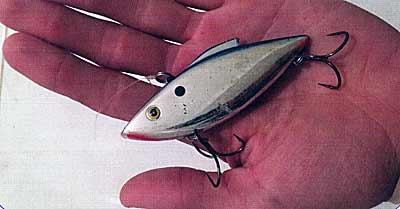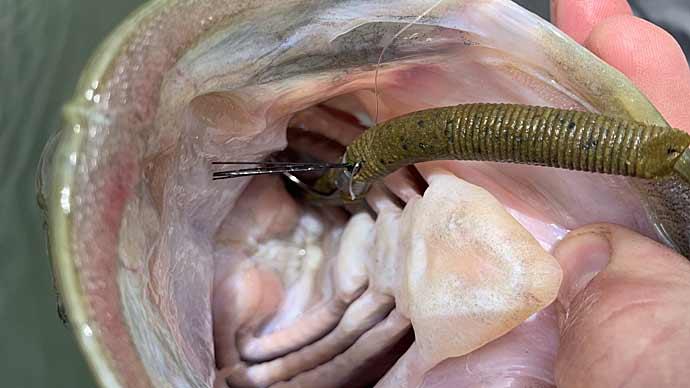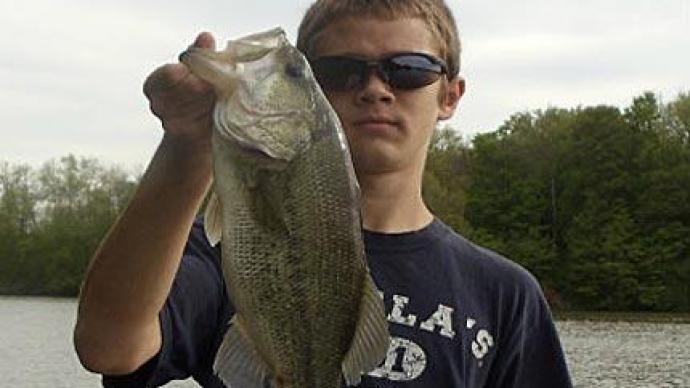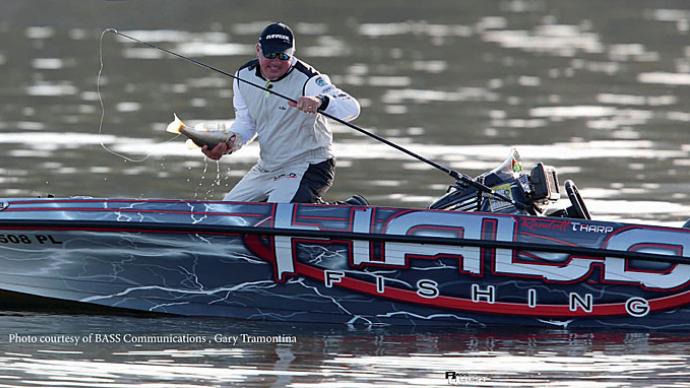
We all know lure presentation is the key to fooling wise and big fish in your pond. There are a thousand variables to examine when choosing what lure to use: color, forage species present, lure size, running depth, and water displacement, to name a few. However, I think there is one variable that gets overlooked far too often: ROF. This stands for Rate of Fall. In my opinion, ROF is important to fool big bass and panfish. If you've spent any time fishing, you've likely experienced a bite when your lure is falling, either in the middle of your retrieve or as your lure is falling on its initial descent.
Let's dive into why these bites happen and what you can do to capitalize.
When looking at bass or bluegill, it's easy to see they naturally eat upward. The shape of their mouth and how it is pointed is a dead giveaway. And although not every nugget a bass eats comes from above, a good portion of it does. Frogs, baby turtles, small birds, rats, and shad are perfect examples. These predatory fish are almost always looking up, and an opportunistic feeder is naturally triggered when it sees something falling close to its strike zone. However, that does not mean that practically anything falling at any speed will get eaten. In my opinion, certain lures and specific ROF rates are needed to fool the biggest predators in your pond.
The first thing to look at when it comes to ROF, in my opinion, is water temperature. Think about your pond in the dead of winter. Regardless of where you are in the states, nothing in your pond moves too fast when it's cold. Our fish, even baitfish, are lethargic. Bass and bluegill I've seen on camera under ice don't appear to be in any rush. The whole pond is moving slower. Frogs hibernate, and the fast-moving minnows and fry are nowhere to be found.
In contrast, when water begins to warm each spring, the pond begins to come to life. Warmer water temperature allows cold-blooded fish to move around, and bluegill are actively looking for a meal. They are more willing to chase it. I am getting that the ROF of a lure in colder water should be a much slower, more natural fall, while the ROF of a lure in the spring, or summer, could be a faster reaction strike type of fall.
For example, I like to use a 1/4 or even 1/8 oz jig in the colder months. The reason for this is it is a slow-falling lure. When nothing else in the pond moves fast, your lure shouldn't either. This small jig falls fast enough to get a fish's attention but, at the same time, is slow enough to entice a strike from a cold, lethargic fish. On the initial descent, and after the jig hits the bottom of the pond, each pull of the rod tip can pull that little jig off the bottom and allow it to fall back to the bottom slowly. That slow fall on cold winter days is key to drawing strikes. If I were to use a % oz jig, that lure would sink at a few feet per second and kick up all kinds of mud on the bottom of the pond. That exaggerated movement is the last thing a fish looks for when the water temperature barely allows them to move.
Not only a jig, but any soft plastic lure that you may like to throw in your pond makes sense. In the colder months, a 1/16 oz bullet weight will allow your creature bait, or Senko, or whatever plastic it may be, to fit right in with the surroundings of the colder water.
As the bass stage for spawning, they are actively hunting for prey, and at this point, I will start using a 1/4 ounce bullet weight for plastics and bump up to a 3/8 oz jig. These lures sink a little faster and will strike up naturally happening in the pond as the water starts to creep from the 50s into the 60s.
Another lure I like to throw as the water warms is a lipless crankbait. This bait is a tool that can get fish to bite, and I think the main reason is how the lure falls. I practically NEVER use crankbaits with a straight retrieve. The change in cadence and depth is key to making the most of a crankbait retrieve, and a lipless crankbait is a great lure to which you can impart a lot of action to make fish bite. When I throw a lipless bait out, I usually use a steady pull up, lower the rod tip (while the lure falls), and then another steady pull up throughout the entire retrieve. If you think about this from a fish's point of view, it helps to understand why this pull/drop technique works so well. The fall of a lipless lure also triggers a fish rise because, to them, a baitfish frantically moving forward, then falling, is a sign of that baitfish being weakened. If you throw a lipless bait into a ball of baitfish, and you pull it into the activity of the bait, and then let it drop below the baitfish, the bass will key in on any injured or hurt bait falling from the activity. The strike on this technique almost always happens on the fall.
The lipless bait garners a lot of attention underwater due to its noisy rattles. Many fish will follow but not commit to it if it does not do anything other than swim straight. When you drop the lipless bait and let it fall, it falls right in the face of any fish following it. Most fish will follow crankbaits from below, and nothing aggravates them more than your lure falling right in their face. I have noticed that fish get hooked very well with this technique. If you do catch a fish on a lipless crankbait while running it straight, the fish will likely be hooked around the mouth. But, the difference when you use the pull-drop technique is that the bait is FALLING right in front of the fish, and they can gulp it into their mouth very easily; therefore, they almost always get the bait where it belongs so your hooks can stick: in the mouth.
On the other hand, a lipped crankbait will usually float when paused, and this rise of the lure can also elicit a strike. Like the lipless crankbait, the change in cadence is what it takes to get bigger fish to commit to a crankbait. My favorite lipped crankbait to use is usually a Strike King 2.5 crankbait. This bait will crash into any cover you throw it in and then bounce off of the cover. I like to pause the crankbait the second I feel it hit any structure, which allows it to float up for a second or two before continuing my retrieve, and that is a serious trigger for any following fish. Like a falling bait can make bass think a bait is injured, a rising bait can have the same effect. Not only that, but the slowly rising bait is easier for a bass to hit than a fast-moving one, so when the fish hit the crankbait on the rise, they are typically hooked much better than if they hit it on the run.
Another forage species many people capitalize on is frogs. Most people like to throw topwater frogs, but I think that one of the best ways to imitate a frog is actually with a sinking lure. Frogs typically move pretty fast underwater. If you scare a frog off the bank, he usually jumps in the water and rushes toward the bottom to find cover. Imitating a frog doing this is a killer way to get a giant bass. Since we want a high-speed ROF lure, I usually go with a Vi or % ounce jig, in a green or light green color, with a craw trailer that vibrates a lot (such as a Rage Craw). Casting this lure on the shore, and pulling it quickly into the water, will get the attention of any bass around. Then pulling it quickly off the bank into deeper water, with the legs pumping like a frog, is deadly. Remember, frogs are generally smart enough to stay out of open water where a bass will eat them, so many bass try to target frogs underwater, and a fast ROF jig, colored like a frog, will fool a big bass.
The last lure I would like to discuss is a weightless wacky rig. This lure works in all water temperatures and conditions because it slowly falls. We want a slow fall in winter, but in the sweltering days of summer, sometimes fish are sluggish from the very warm water. In these cases, a slow-moving, natural bait can shine. A Senko, or any plastic worm, rigged through the middle of the bait on a J hook is all that this bait is. This bait falls incredibly slow due to the lure being weightless and the extra water resistance from the bait falling horizontally (because it is rigged through the center of the bait).
Throwing a lure like the weightless wacky rig will give you the slowest possible ROF of any lure you can throw in your pond. And with each pull of the rod tip, the lure rises slowly and falls even slower. Why is this important? When bass are very cold or warm, they aren't looking to chase a meal. The slow fall of this bait assures they can catch it very easily. Another great thing about this bait is that it can catch suspended fish. If a big fish sits at 5 feet of water on a 10-foot drop-off, she may not be willing to chase your jig down to 10 feet. BUT, this lure falls so slowly in front of her that she doesn't have to chase it. If you can imagine a spot in your pond where bass are holding, but you are having a hard time catching them, patiently fish a wacky rig in front of them. It may be trying at first because the lure sinks slowly, but not many fish will turn down a weightless worm slowly falling in front of them. Although ROF may not be the first thing on every angler's mind, in my opinion, it can make or break a day of fishing. The switch from a faster sink to a slower sink can be just the ticket to catching that many more fish or enticing that one big bite. The initial fall of my lure is always the most critical part of my retrieve.
The water is likely warming up in your pond right now—and a big fish is probably waiting for your lure to fall right in front of her—so the question is, why are you still reading this?
Reprinted with permission from Pond Boss Magazine




